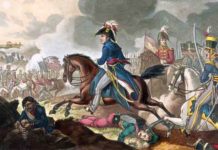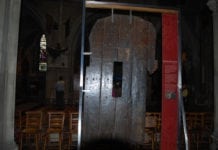Glenn Miller, the famous bandleader, vanished without trace en route to entertain Allied troops in 1944, but what happened to him?
At the end of the 1930s, just as the Second World War was breaking out in Europe, Glen Miller’s band introduced America to the new, unique style of brass-band music they had been working on for a number of years.
It was a smooth, upbeat sound that struck an instant chord both with the middle-aged and an optimistic youth learning how to jive and swing.
Radio stations across America played Glenn Miller records all the time and Hollywood was quick to sign up the new star and his band. Two films were released: Orchestra Wives in 1941 and Sun Valley Serenade in 1942.
The Glen Miller Orchestra were the Beatles of their generation (or, for the younger reader, Oasis; and if you’re thinking of One Direction, then you should be in bed by now).
By early 1942, America had entered the fray, joining the Allied Forces in their efforts to repulse the Nazis.
Miller enlisted later that year, on 7 October. On completion of his basic training, he transferred to the Army Air Corps: his first military assignment was to gather another orchestra, the Glenn Miller Army Air Force Band, with a brief to entertain Allied troops in Britain.
He was delighted to be back in touch with his old Hollywood friend David Niven, whose job it was to arrange entertainment for the troops across Europe.
Eighteen months later, the D-Day landings signalled the start of the liberation of Europe and by November 1944 Paris was finally free of German soldiers.
Even though Allied Bombers were still pouring across the English Channel on their way to tackle targets further into Europe, the Parisian party was now in full swing.
David Niven organized a six-week tour for the Glenn Miller Band that was to begin in the French capital on 16 December 1944. The band were due to arrive on the 16th, but Miller wanted to travel a few days early to attend what he called a ‘social engagement’.
Arrangements were duly made for him to fly from the airfield at Twinwood Farm near Bedford in a small American-built, propeller-driven craft called a ‘Noorduyn Norseman’ that would be piloted by John R. Morgan.
Lieutenant Don Haynes, a show-business agent drafted into the US Air Force to manage the Glenn Miller Orchestra while on tour, drove his famous charge from London to RAF Milton Earnest to prepare for his cross-Channel flight the following day.
According to Haynes, John Morgan arrived in the Norseman at Twinwood Farm at 1.40 p.m., collected Miller and, in spite of poor weather conditions, took off again at approximately 1.45 p.m. This was the last anyone saw of Glen Miller: he had vanished from the world and into the history books.
The alarm was raised when he failed to meet up with Don Haynes and the band in Paris four days later. After a frantic search of the entire city’s likely haunts, the Glenn Miller Orchestra had to play the show without their famous bandleader, announcing that ‘Major Miller cannot be with us tonight’.
Nobody ever saw him again, or, at least, could prove that they had. The puzzle began in earnest when, just three days later, the United States military announced his death, which was extraordinary in itself, given that in the confusion of a recently liberated France many people went missing for much longer periods, often ‘absent without leave’ (AWOL).
The question was why would officials make such a final announcement so soon after the musician, albeit a world-famous one, simply failed to show up at a few concert performances? Pete Doherty does that all the time these days and nobody announces him dead as a result.
It was a question Helen, Miller’s wife, also asked but not until over a year later, in February 1946, when Colonel Donnell wrote to inform her that her husband had been flying that day in a combat aircraft, not the Norseman, and that the plane had taken off from Abbots Ripton airfield near Huntingdon in Cambridgeshire, many miles from where Haynes had left Miller.
The mystery deepened when it was claimed that the flight had been bound for Bordeaux, far from Miller’s intended destination. There was no explanation of how he would be travelling the remaining distance within France.
In fact, no further information was given at all, and so speculation raged about whether Miller had lied about his movements to his friends and the rest of the band, changing his stated plans at the last minute, or had gone AWOL, or even that he had been shot down by enemy fire.
A military cover-up seemed increasingly likely. Imagine that: the military might not be telling the truth about something!
After the war, John Edwards, a former RAF officer, set out to prove Miller had been on board the Norseman, for which all he needed was a copy of the official accident report from the National Personnel Records Center in St Louis.
But he drew a blank: that office maintained that the records had been ‘lost in a fire’, while the Washington Department of Records denied such a file had ever existed. Edwards’ efforts to prove the absence of a military cover-up began to convince him that the reverse must be true.
What he now wanted to know was why. And when some documents were finally discovered, they were found to be written illegibly, the signature blurred and undecipherable.
This, strengthened by the fact that the military had initiated no search of any kind for the missing bandsman, began to fuel speculation that the US government knew exactly what had happened to Glenn Miller and had known it immediately, hence the early announcement of his death.
After all, imagine Oasis singer Liam Gallagher going missing on a morale-raising visit to troops in Iraq, there being no search for him and the UK government firmly announcing he was dead only three days later, but without producing a body.
Furthermore, no records of what had happened to him would ever be released while every government agency claimed to know nothing about it.
On second thoughts, that is a bad example. With today’s government, led for so long by Tony Bliar (sic), and with the current Conservative replacement, it is all too easy to imagine.
What is known is that the Norseman did crash into the sea, as it was discovered by divers in 1985 six miles west of Le Touquet in northern France, but there was no evidence that Miller, or indeed anyone else, was on board at the time and the reasons for the accident remain inconclusive. All that was revealed is that the propeller was missing but not when or how it fell off.
In 1986 the novelist and former RAF pilot Wilbur Wright took up the challenge and asked the US Air Force Information Center in California for the accident report on the missing Norseman.
He was informed that no accident had been reported on that day and, in fact, no Norseman aircraft had been reported as missing throughout December 1944. Another mystery and another lie, as Wright subsequently discovered that eight Norsemen had been reported missing that month.
Wright then repeatedly wrote to every US state department and records office he could find requesting information relating to the disappearance of Glenn Miller. But he was ignored until his letter of complaint to President Ronald Reagan encouraged a response out of the Military Reference Office.
They confirmed there were several documents relating to the accident, but then failed to produce them. However, all other departments continued to insist all records had been lost, destroyed, mislaid or had never existed in the first place.
When Wright telephoned George Chalou, the man in charge of the records office, to complain, he was alarmed by Chalou’s reaction during the conversation.
According to Chalou (in a taped conversation with Wright): ‘They will never get them [the files] back either. Those files have been under lock and key for years and that is where they will be staying.’ There had been a cover-up after all.
After extensive research, Wilbur Wright’s eventual conclusion was worthy of one of his own novels: that Glenn Miller probably had arrived in Paris two days before his band, where he was met by David Niven.
Niven then set off to dramatically rescue Marlene Dietrich from the clutches of the Nazis, while Miller holed up in a brothel in the Parisian red light district awaiting their return. Unfortunately, with time on his hands (and plenty of alcohol), he ended up becoming involved, and badly injured, in an unseemly bar brawl.
The American authorities were horrified to discover the world’s best-loved musician in a seedy brothel with a fractured skull. Miller was immediately airlifted to back to Ohio, but he later died of his injuries.
Wright proposes three main strands of evidence. The first is based on the fact that David Niven makes no mention of Miller in his autobiography The Moon’s a Balloon, published in 1971, despite the pair knowing each other well.
Wright sees this as indicating Niven’s awareness of the incident and his decision, for the sake of good grace and the Miller family honour, never to mention it again. (Indeed, he never even mentioned the name Glenn Miller to either his biographer, Sheridan Morley, or to his second wife.)
The second line of ‘proof’ given by Wright is that Helen Miller soon moved to Pasadena in California where she bought a burial plot with room for six graves. As her immediate family consisted of five people – herself, her son, daughter and parents – it is therefore assumed that Miller himself occupies the last plot.
When asked, the cemetery administrators denied Miller’s presence but took a full fifteen months to reply to Wright’s letter of enquiry, suggesting to Wright that both the family and local grave diggers were in on the cover-up.
For him the clinching piece of evidence is that, in 1954, a Parisian prostitute – still plying her trade opposite Fred’s Bar, the brothel bar where Miller was alleged to have been drinking the night he went missing – told somebody that her then boyfriend had told her what had happened to Glenn Miller, confirming the whole Parisian brothel story.
If that all seems a bit thin – and let’s face it, it does – that’s because the authorities only needed to remove one word and the whole cover-up could have been completely unnecessary. Think about the difference between reading ‘Glenn Miller died after being involved in a fight in a brothel bar’ and ‘Glenn Miller died after being involved in a fight in a bar’.
That’s it, no international outcry, just a respectable period of public mourning. No shame would have been heaped upon the Miller family and no extensive and complicated cover-up story would have been necessary.
But if Wright’s hypothesis is true, how could all those people who would need to have been involved for this story to have any basis in fact – including any witnesses, the French police, military personnel, flight crew, medics, doctors, nurses, administrators, grave diggers, family, friends, Uncle Tom Cobbley and probably Inspector Clouseau himself – have not failed to give the game away hundreds of times over the ensuing fifty years?
Instead we have the silence of a film star, a six-berth burial plot and the testimony of a Parisian tart well past its sell-by date.
My vote goes with the recent evidence that has emerged that Miller was on board the Norseman after all. The new story has a much more convincing explanation of the American fear of the truth coming out. According to this theory, Miller boarded the Norseman at Twinwood Farm on 14 December 1944, just as Don Haynes said.
The aircraft took off at 1.45 p.m. By 2.40 p.m. it was travelling through what was known as a jettison zone in the English Channel, an area set aside for returning bombers to drop their undischarged loads safely into the sea before they crossed the south coast.
A fully laden bomber exploding on landing could wipe out an entire air base, so the jettison zone was stringently enforced.
The only bomber to use the jettison zone that afternoon is known to have crossed it at around 3.40, at the time Miller should have been landing in Paris, and so it has never been thought relevant to the Miller mystery before.
However, it has only recently been noticed that, while the Miller flight would have been charted on Greenwich Mean Time (GMT), all military flight operations were logged using Central European Time, which is one hour later.
Therefore bombers were releasing their loads directly over the area Miller’s Norseman would have been flying through, at a much lower level and in the opposite direction.
Did the Americans hit their favourite musician with some not-so-friendly fire? There is certainly strong witness evidence to suggest they did, including some of the military aircrew themselves.
Fred Shaw, a navigator in one of the bombers, claimed, in an interview for an amateur film, that he saw the bombs his aircraft jettisoned strike a small plane beneath him. According to Shaw: ‘I had never seen a bombing before so I crawled from my navigator seat and put my head up into the observation blister.
I saw a small high-wing monoplane, a Noorduyn Norseman, underneath us.’ Mr Shaw claimed he didn’t make any connection to the disappearance of Glenn Miller until he saw The Glenn Miller Story in 1956. ‘There is a kite down there, I told the rear gunner, there’s a kite gone in,’ Shaw continued. ‘He then replied, yeah, I saw it too.’
At the time authorities had dismissed his claims as a publicity-seeking exercise, but Shaw remained adamant he had seen the small plane spiral out of control as a result of being hit.
In a sworn statement, given on 10 April 1999, Fred W. Atkinson Jr, a member of the 320th Air Transport Squadron responsible for taking Miller to Paris, stated the following:
You will recall in the movie, The Glenn Miller Story, the letter that Glenn Miller wrote to his wife that day [in which] he expressed the feeling that he might not see them again. Given the weather conditions and the type of aircraft that was a realistic probability. Several days after our plane left London, we were notified that an aircraft that might be ours had crashed on the coast of France and that the occupants were dead.
We dispatched a plane to that location and the aircraft and the bodies of our pilots were identified. Our crew also said that the other body definitely was that of Glenn Miller. They said there were identification papers and dogtags on his body. Our second crew that was in London at the time verified they had witnessed Glenn Miller and our two pilots board the aircraft and depart Twinning Farm.
I recall the papers being processed to salvage our aircraft and report the death of our pilots on the squadron morning report. This report was turned in on a daily basis and notes the changes in status of all personnel as they occur. We had not experienced any deaths in our squadron until this time and this was a ‘double whammy’ to us because of the loss of our pilots and the loss to the US Armed Forces of probably the greatest morale booster (along with Bob Hope) that we all loved.
The flight logbook of another airman, Derek Thurman, appeared to corroborate the claim: ‘The bomb aimed down in the nose saw an aircraft first, [and] remarked on it.
The navigator shot out of his seat to have a look through a side blister [window] and he saw it sort of whip by, then the rear gunner said “it’s gone in”, sort of flipped over and went in.
Whether it was brought down by a blast from one of the bombs, or was hit, is anybody’s guess, really.’
These three reports, all from independent sources, are consistent in the details they provide. The idea that a small aircraft could have been hit or damaged by an explosion nearby, thus causing its pilot to ditch it on to the beach, breaking its propeller, is not so far-fetched.
And if so, the idea that the American military may have recovered the bodies, then dragged the prop-free plane back into the sea and created a cover story, is a racing certainty.
It tends to be the case that the first information to emerge from a suspicious incident such as the Miller mystery is the most accurate and reliable, especially where governments are concerned, as they won’t have had time to concoct a story to suit their purposes.
For my money, Miller was accidentally shot down by the very military he was travelling to Europe to entertain.
The Miller family were told the truth, which explains the sixth burial plot, and in return for their patriotism in never speaking publicly of the accident, were handsomely compensated for their loss.
David Niven, on the other hand, was warned he would never work in Hollywood again if he ever mentioned the matter to anybody, so he didn’t; and the French prostitute was just looking to sell a story for enough francs to buy a new horse whip and a couple of cheap bottles of Beaujolais.
It is hard to conceive of a more ludicrous story than the idea Glenn Miller was beaten up in a Parisian bordello and died of his injuries. In the case of Liam Gallagher, however, I doubt there would be any such cover-up if he was found dead in a Basra brothel.
Although these days it’s far more likely he would be stabbed on the school run by a teenager after his mobile phone. – Albert Jack
Albert Jack AUDIOBOOKS available for download here
Albert Jack’s Mysterious World






































